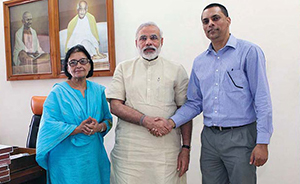Garbh Upanishad
At a time conducive to conception, with the union of male and female, after a lapse of one night, embryo is a semi-fluid. It takes the form of a bubble on the seventh night, a solid lump at the end of fortnight. It hardens by a month, head forms at the end of two months, feet after three months, stomach and hips after fourth, backbone develops in fifth, eyes-nose-ears in sixth. In the seventh month the embryo gains consciousness and by the eighth month it is complete. If the potency of the father is stronger, it becomes a male and vice versa. If the potency of both is equal, it becomes a neuter. Deformities are caused if either of the parents is agitated at the time of conception. Twins are born due to splitting of seed as a result of movement of air. It derives its nourishment from whatever is consumed by the mother through nerves and vessels.
This five-fold-self combined with intelligence immerses itself in eternal om, whereupon it derives the essence of eight natures and their sixteen modifications. In the ninth month, it is reminded of all the past lives, the karmas it performed – good and bad. The fetus contemplates that it has seen innumerable wombs and taken countless pleasures, been born and reborn repeatedly. It has borne pain and brief and sees no respite, it is suffering alone and the bodies that enjoyed the pleasures are gone. So it pledges to immerse itself in yoga once it exits the womb to carve its journey back to the source – to Maheshwar, Narayana and Brahma. But the moment it comes out of the womb, it is touched by vaishnav prana, maya, and forgets its past lives and deeds and also, the promise it made…because its priority is different. The journey thus begins…
At Dhyan Ashram, sadhaks have had experiences which complement what is documented in the Upanishad and all of them are educated individuals with sound minds. Dr Prasan Prabhakar, who is an MBBS MD Medicine, has been practicing Sanatan Kriya in Kochi and reported seeing a white tube, the same which is described as the entry and exit route for the soul in vedic texts. Seema Singh, MBA in Marketing from Hyderabad, after a dhyan session, described her past four lives, how she was murdered in her last birth and how the soul entered the womb of present mother, the mother’s labour pains and her subsequent birth, corroborating the continuity of life and consciousness of the soul as described in Garbha Upanishad. And these are just two examples.
The Garbha Upanishad calls human life a yagya which uses the three fires in the body, Koshta agni (digestive fire), Darshana agni (which powers our sight) and Gyan agni (the power of discernment). Soul is the yajman; Mind is Brahma, grosser thoughts and desires are sacrificial objects, mental strength is the vow; intellect and sense organs are utensils, motor organs are the havish (performers of sacrifice), skull is the vessel, hair is darbha grass, face is the altar and teeth are other utensils.
Rishi Pipalaada goes on to detail human anatomy with 107 marmas, 180 junction points, 109 snayus, 700 channels, 500 muscles, 360 bones, four and a half crore hair, heart weighing 8 palam and tongue weighing 12 palam. The body has one prashta pitta, one adhak kapha, one kudava sukra and two prashtas of fat. The measure of excretory waste depends on intake. The sage described the body and its journey in detail 4000 years ago urging the being to perform the yagya of life. The success of which, that is fulfilment of the purpose of birth, lies at the feet of Guru.
Article from Ashwini Guruji of Dhyan Ashram











Comments.